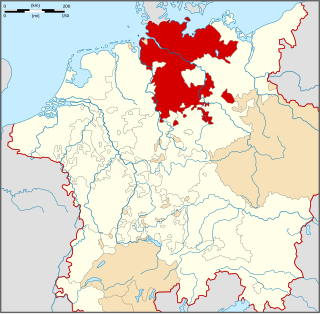
Lower Saxony is a German state in northwestern Germany. It is the second-largest state by land area, with 47,614 km2 (18,384 sq mi), and fourth-largest in population among the 16 Länder federated as the Federal Republic of Germany. In rural areas, Northern Low Saxon and Saterland Frisian are still spoken, albeit in declining numbers.

Westphalia is a region of northwestern Germany and one of the three historic parts of the state of North Rhine-Westphalia. It has an area of 20,210 square kilometres (7,800 sq mi) and 7.9 million inhabitants.

A Regierungsbezirk means "governmental district" and is a type of administrative division in Germany. Currently, four of sixteen Bundesländer are split into Regierungsbezirke. Beneath these are rural and urban districts
Schaumburg is a district (Landkreis) of Lower Saxony, Germany. It is bounded by the districts of Nienburg, Hanover and Hameln-Pyrmont, and the state of North Rhine-Westphalia.

The Duchy of Brunswick was a historical German state that ceased to exist in 1918. Its capital was the city of Brunswick. It was established as the successor state of the Principality of Brunswick-Wolfenbüttel by the Congress of Vienna in 1815. In the course of the 19th-century history of Germany, the duchy was part of the German Confederation, the North German Confederation and from 1871 the German Empire. It was disestablished after the end of World War I, its territory incorporated into the Weimar Republic as the Free State of Brunswick.

The Lower Saxon Circle was an Imperial Circle of the Holy Roman Empire. It covered much of the territory of the medieval Duchy of Saxony, and was originally called the Saxon Circle before later being better differentiated from the Upper Saxon Circle by the more specific name.

The Province of Hanover was a province of the Kingdom of Prussia and the Free State of Prussia from 1866 to 1946.
This is a list of coats of arms of Germany.

The coat of arms of North Rhine-Westphalia is the official coat of arms of the German state of North Rhine-Westphalia.

The coat of arms of the present-day German free state of Saxony shows a tenfold horizontally-partitioned field of black (sable) and gold/yellow (or) stripes, charged with a green (vert) crancelin running from the viewer's top-left to bottom-right. Although the crancelin is sometimes shown bent (embowed) like a crown, this is due to artistic license. The coat of arms is also displayed on the state flag of Saxony.

The County of Schaumburg, until ca. 1485 known as Schauenburg, was a state of the Holy Roman Empire, located in the present German state of Lower Saxony. Its territory was more or less congruent with the present district Landkreis Schaumburg.

Both the civil and state flag of the German state of Saxony feature a bicolour of white over green, similar to the Austrian province of Styria although they are historically not related to each other. The state flag is similar to the civil flag, except it is defaced in the centre with the coat of arms of Saxony. The colours of both flags were officially decided as state colours in 1815 in the Kingdom of Saxony. The aristocracy used mostly and in first time the quadrangular version and later the rectangular.

The Saxon Steed is a heraldic motif associated with the German provinces of Lower Saxony and Westphalia, and the Dutch region of Twente.

Lower Saxon cuisine covers a range of regional, North German culinary traditions from the region correspondingly broadly to the state of Lower Saxony, which in many cases are very similar to one another, for example cuisine from the areas of Oldenburg, Brunswick, or East Frisia.

The State of Hanover was a short-lived state within the British Zone of Allied-occupied Germany. It existed for 92 days in the course of the dissolution of the Free State of Prussia after World War II until the foundation of Lower Saxony in 1946. The state saw itself in the tradition of the former Kingdom of Hanover, annexed by Prussia in 1866, reflected in the Saxon Steed state emblem. After Lower Saxony was founded by merging Hanover with several smaller states, it continued to use the Hanover emblems.

The Minister-President of Lower Saxony, also referred to as Premier or Prime Minister, is the head of government of the German state of Lower Saxony. The position was created in 1946, when the states of Brunswick, Oldenburg, Schaumburg-Lippe and the State of Hanover were merged to form the state of Lower Saxony. The current Minister President is Stephan Weil, heading a coalition government between the Social Democrats and the CDU. Weil succeeded David McAllister following the 2013 state election.

Oldenburg is a former state in northwestern Germany whose capital was Oldenburg. The region gained its independence in the High Middle Ages. It survived the Napoleonic Wars as an independent country, formed part of the German Confederation, and was a member state of the German Reich from 1871 to 1946.

The flag of Lower Saxony consists of the flag of the Federal Republic of Germany in Schwarz-Rot-Gold, with the coat of arms of Lower Saxony, shifted slightly toward the hoist. This flag is the civil and state flag. A double tailed version in 3:5 ratio is used as the state ensign.

The 1st Mechanized Infantry Brigade in Hildesheim was a formation in the Bundeswehr, which was subordinated to the 1st Armoured Division in Hanover. The Brigade was disbanded on 31 December 2007. During its lifetime the Brigade was stationed between the Lüneburg Heath, Harz Mountains, the Solling hills and the River Weser.































